School Organizational Practices And The Challenges Of Remote Teaching During A Pandemic
This post is part of our series entitled Teaching and Learning During a Pandemic, in which we invite guest authors to reflect on the challenges of the Coronavirus pandemic for teaching and learning. Our guests today are Matthew A. Kraft, Associate Professor of Education and Economics at Brown University and Research Director at Upbeat, and Nicole S. Simon, director in the Office of K-16 Initiatives at the City University of New York. Other posts in the series are compiled here.
The COVID-19 pandemic has shuttered schools across the United States, upending traditional approaches to education. The health threats posed by the Coronavirus, a sudden shift to remote teaching, and added caretaking responsibilities at home have created a uniquely stressful and demanding context for teachers’ work. Major concerns exist about teachers’ wellbeing during the pandemic and their ability to successfully deliver instruction remotely. Teachers have also expressed apprehension about their willingness to return to the classroom when schools are able to reopen. Even more troubling are projections of substantial student learning loss and the likelihood that differential access to technology and learning supports at home are exacerbating longstanding achievement gaps along racial and socio-economic lines.
We developed the “Teaching From Home Survey” for Upbeat to support districts in better understanding and responding to teachers’ experience in working remotely. Between April 27 and May 26, 2020, a diverse sample of 7,195 teachers working across nine southern, midwestern and eastern states answered the survey. 78% of teachers responded to the survey, including teachers working across 8 districts and 3 charter school networks in rural, suburban, and urban areas. Our analyses complement and extend recent findings by smaller, nationally representative surveys by USA Today, Educators for Excellence, Ed Week, and RAND. The large and diverse sample of respondents allow us to explore how teachers’ experiences working remotely differ across both individual and school characteristics.
Our findings suggest that the sudden move to remote teaching has created substantial challenges for teachers’ work and limited the degree to which students can engage in learning. We find that mid-career teachers — those most likely to have children at home — have particularly struggled to balance their work responsibilities with their home lives during the pandemic. And veteran teachers are over three times more likely than early-career teachers to report being uncomfortable using the technological tools required for teaching at home. Importantly, schools with more supportive working conditions have been far more successful at helping their teachers maintain a sense of success during the pandemic.
Teachers estimate that, on average, only 60% of their students are engaged in remote learning on a regular basis, with wide gaps in perceived engagement along racial and socio-economic lines. Teachers working in high-poverty schools and in schools that serve a majority of Black students report that their students are facing dramatically more challenging experiences engaging in school. Their students are less likely to have the technology they need to access online resources and, consequently, are less likely to engage in remote learning activities regularly.
Supportive working conditions are critical for teachers’ sense of success during the pandemic
We asked teachers to report whether they felt successful at their job when they were teaching in person, prior to the pandemic, and now, during the pandemic while teaching from home. We then constructed an overall measure of working conditions during the pandemic by combining teachers’ responses to the seven working condition questions about the degree to which their district, school administrators and peers are supportive.
- In schools with highly-supportive working conditions, the percent of teachers who feel successful declined only slightly by 6 percentage points, from 99% to 93%.*
- In schools with unsupportive working conditions, the percent of teachers who feel successful plummeted by 42 percentage points, from 90% to 48%.
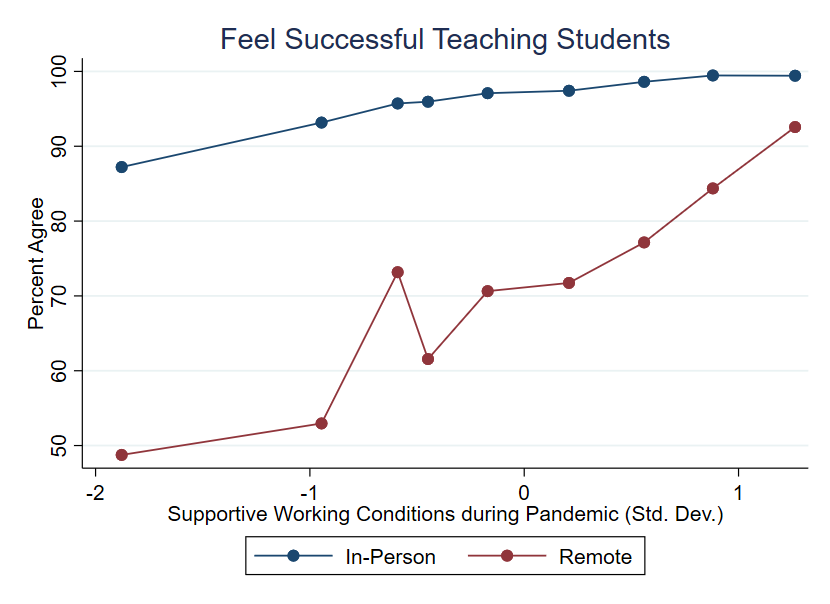
Even with district support, teaching remotely during the pandemic has been a major challenge
Teachers’ sense of success dropped substantially after the transition to remote teaching.
- Overall, the percentage of teachers who feel successful dropped from 96% to 73%.
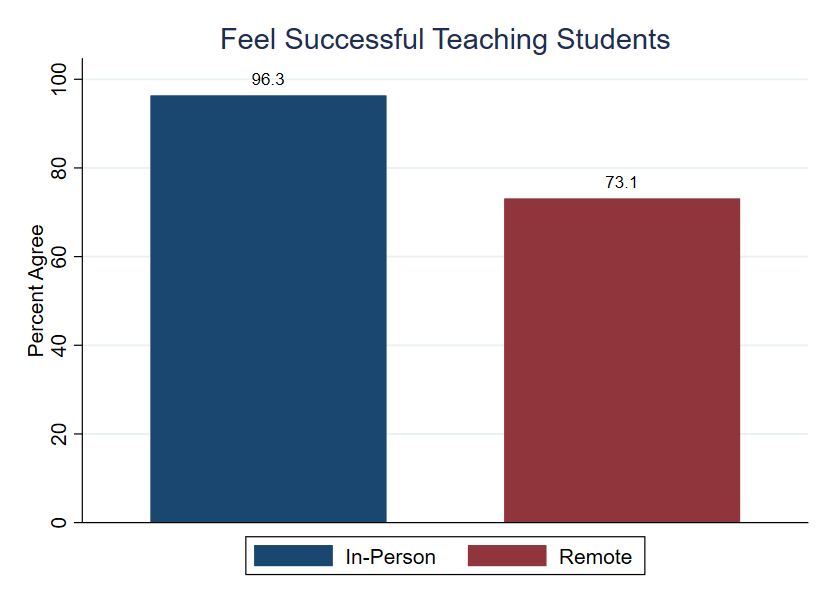
We also find that early-career teachers’ sense of success dropped the most relative to their more experienced peers.
- The number of early-career teachers (those with fewer than five years of experience) that feel successful dropped by 29 percentage points, compared to a 25 percentage point drop for mid-career teachers (those with between 5 and 15 years of experience) and a 19 percentage point drop for veteran teachers with more than 15 years of experience.
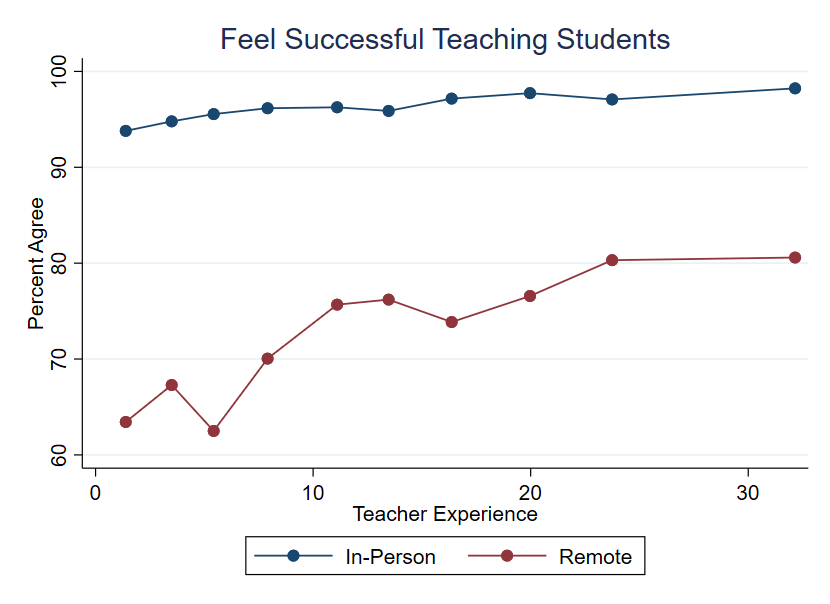
Teachers, particularly mid-career teachers, are struggling to balance their work with the demands of their personal lives during the pandemic.
- Overall, 16% of teachers report that they have struggled to balance their work with other responsibilities, with higher rates for female teachers (17%) than male teachers (12%).
- Overall, 41% of teachers report that caretaking responsibilities for children or dependent adults have made it difficult to do their job, with slightly lower rates for female teachers (40%) compared to male teachers (43%).
- These overall averages mask substantial variation where mid-career teachers (those with between 5 and 15 years of experience) report substantially greater challenges than their early- and late-career peers. For example, 51% of mid-career teachers report that caretaking responsibilities make their job difficult, while 39% of early-career teachers and 30% veteran teachers report these same concerns. These patterns likely reflect the greater likelihood that mid-career teachers have children at home with them.
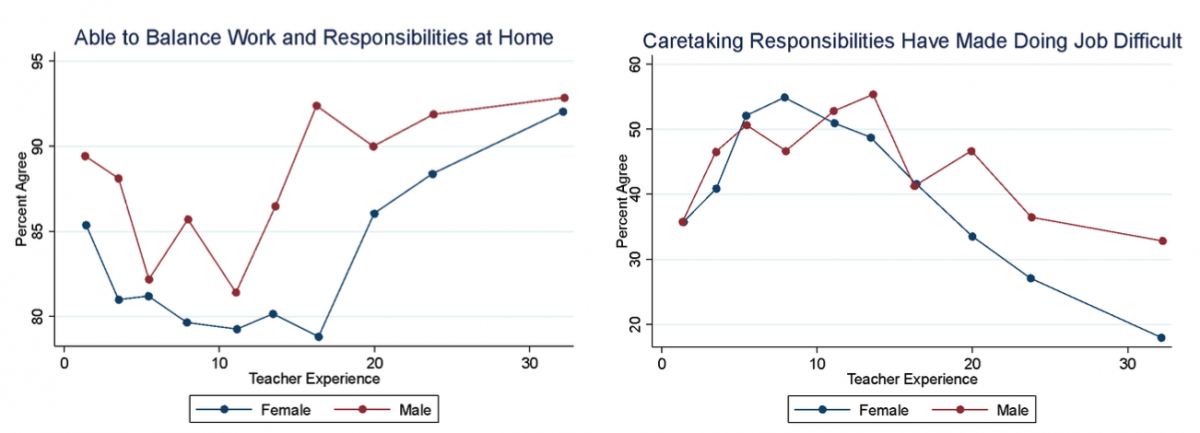
Late-career teachers also report being less comfortable teaching online.
- Overall, 9% of teachers felt uncomfortable using the technological tools required for remote teaching.
- However, 13% of teachers with 20-29 years of experience and 22% of teachers with 30 years of experience or more were not comfortable using online teaching tools, compared to only 6% of teachers with less than 10 years of experience and 7% of teachers with 10-19 years of experience.
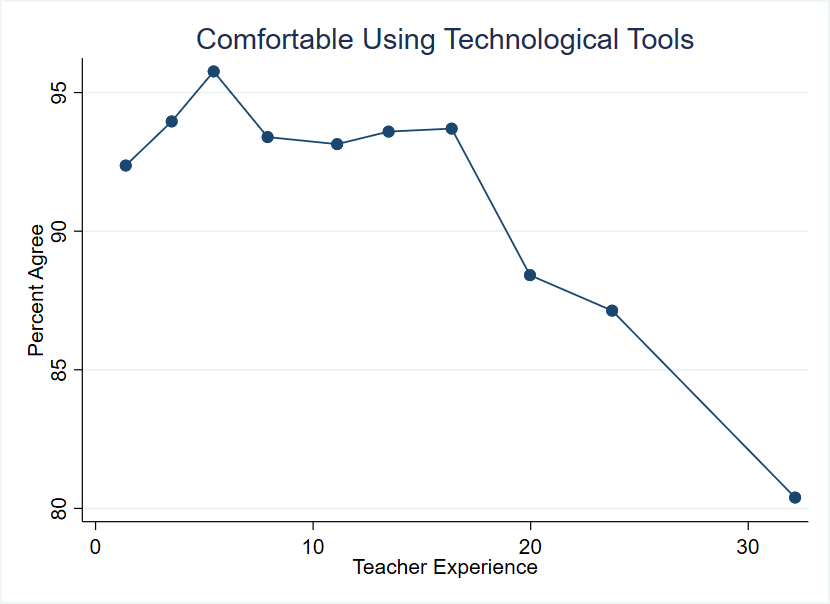
Teachers report concerning levels of student engagement with remote learning overall, and stark differences along racial and socio-economic lines
- On average, teachers report that only 60% of students regularly engage in remote learning activities.
- Teachers in high-poverty schools report that only 50% of students regularly engage in remote learning, whereas their counterparts at low-poverty schools engage at a much higher rate -- 75%.
- In schools where a majority of students are Black, teachers report that 45% of students regularly engage in remote learning; at schools that enroll fewer than 10% of Black students, teachers report that 72% of students regularly engage in remote learning.**
- The differential patterns of perceived student engagement in remote learning by race and socio-economic status likely reflect systemic disparities across communities in education, economic, and health conditions. For example, both low-income and Black communities have been disproportionately affected by the coronavirus, face greater job losses due to the pandemic, and are more likely to lack resources for remote learning. Research has also shown that schools serving these communities have systematically less supportive working environments for teachers (Johnson et al. 2012).
Teachers also report that student access to technological tools is a major challenge for remote learning.
- Overall, only 75% of teachers report that their students have the technological tools necessary for remote learning.
- Among teachers in high-poverty schools, only 64% agree their students have the necessary technology for remote learning relative to 87% in low-poverty schools.
- In schools where the majority of students are Black, teachers report that only 66% of students have the necessary technology to engage in remote learning. In schools where less than 10% of the students are Black, 81% of teachers state that their students have the necessary technology for remote learning.
Conclusion
In our prior research, we and many others have studied the working conditions that matter most to teachers -- strong leadership, effective working relationships with colleagues, and positive dynamics with students and their families. Our findings here highlight how school organizational practices matter now more than ever. Teachers in every career phase and life stage have struggled with the shift to remote teaching, but not always in the same ways. Teachers in schools serving larger populations of low-income and Black students also report that their students are facing disproportionately greater challenges engaging in remote learning.
Supportive working conditions in schools play an important role in helping teachers address these challenges—and are most critical in times of rapid, uncertain change. Concretely: strong, ongoing communication from those at the top, coupled with the creation of deliberate teacher teams that are actively supported by administrators will go a long way in making teachers feel supported and, in turn, effective with their students. Furthermore, attention to the details of organizational functioning must now include acknowledging the challenging personal circumstances affecting teachers' day-to-day work. Schools must help teachers figure out how to balance their many obligations rather than trying to compete with them.
***
* We define highly-supportive working conditions as those more than 1 standard deviation above the mean and unsupportive working conditions as those more than 1 standard deviation below the mean.
** These results are quite similar even when we limit our sample to only include Black teachers.

Very interesting research. A
Very interesting research. A real-time study of the Corona virus is more reliable and allows the heads of the education system to build future programs based on this research, improve the technological capabilities of teachers and students, and make them available.